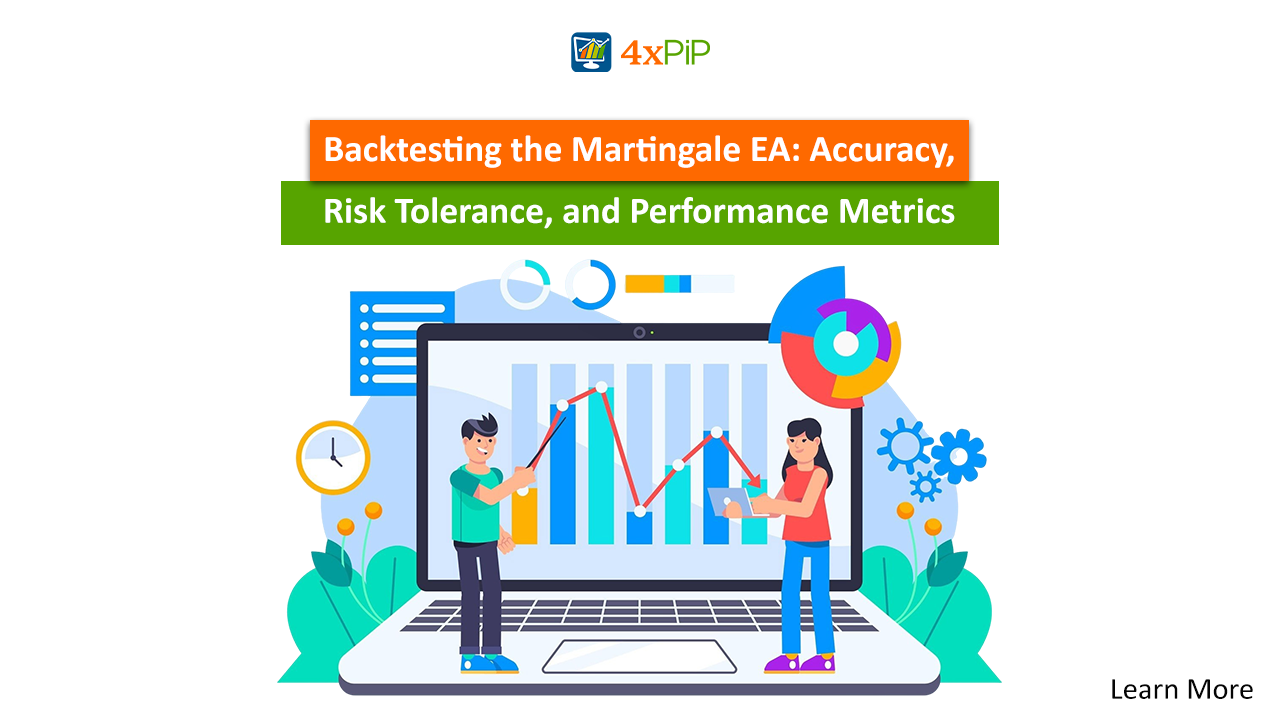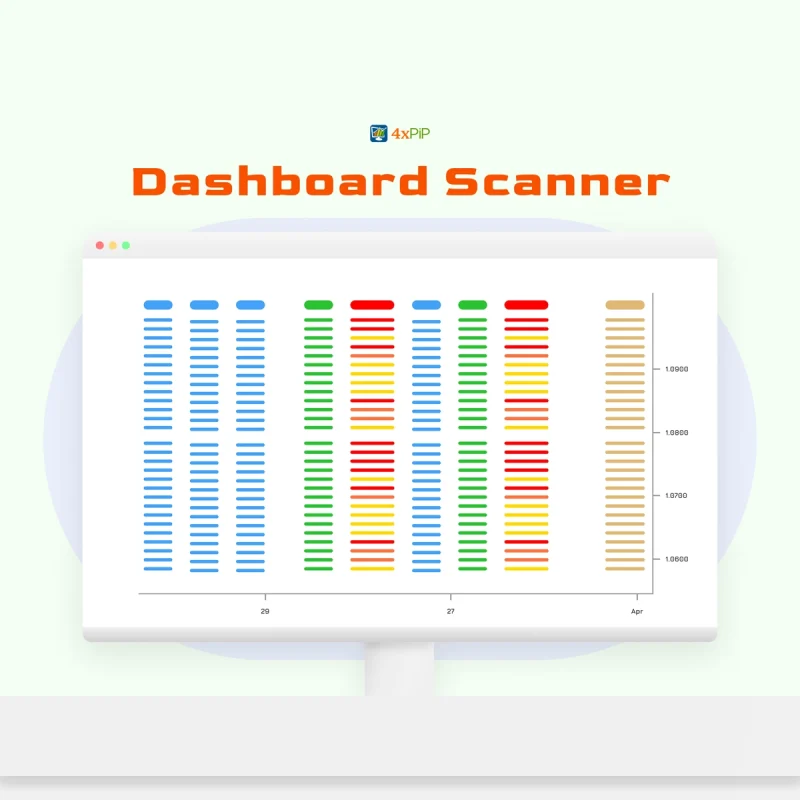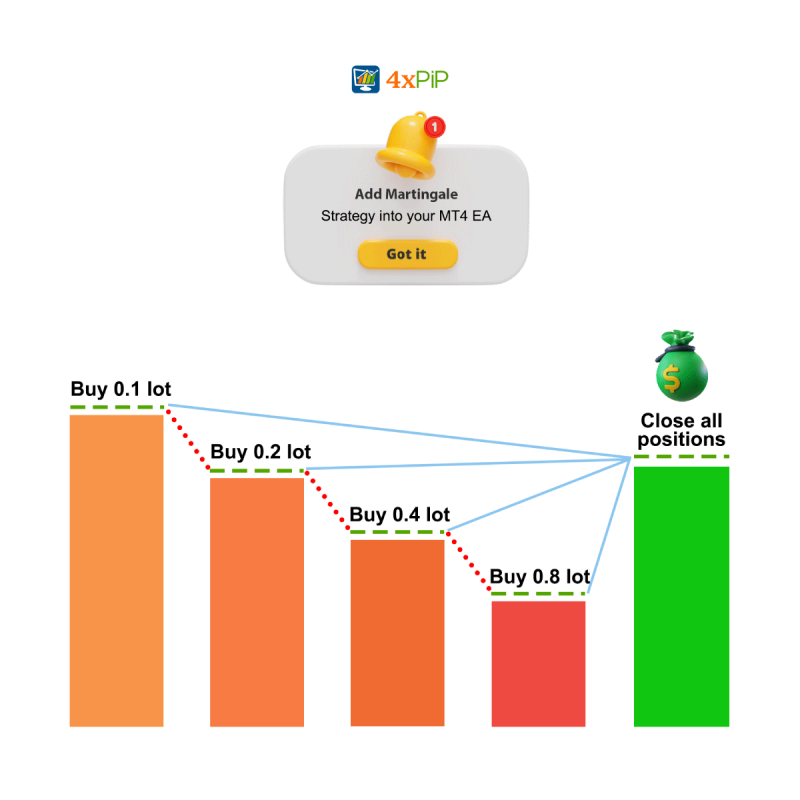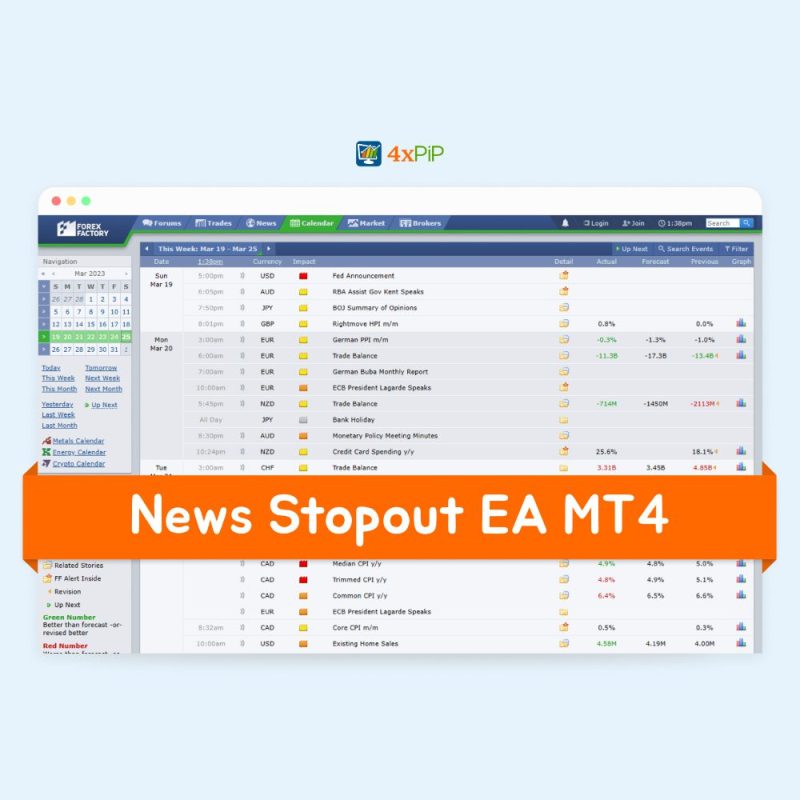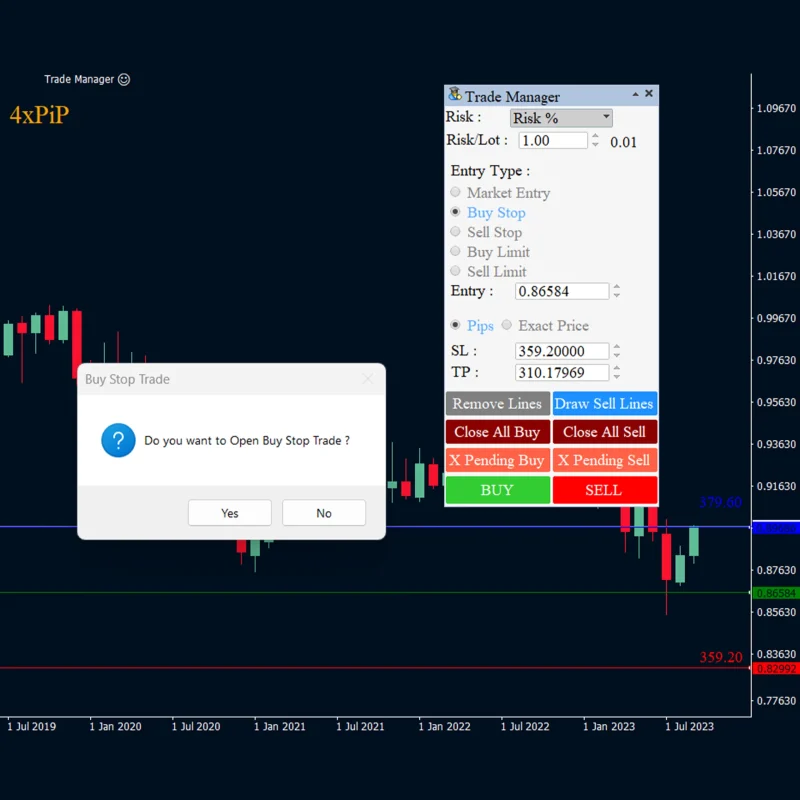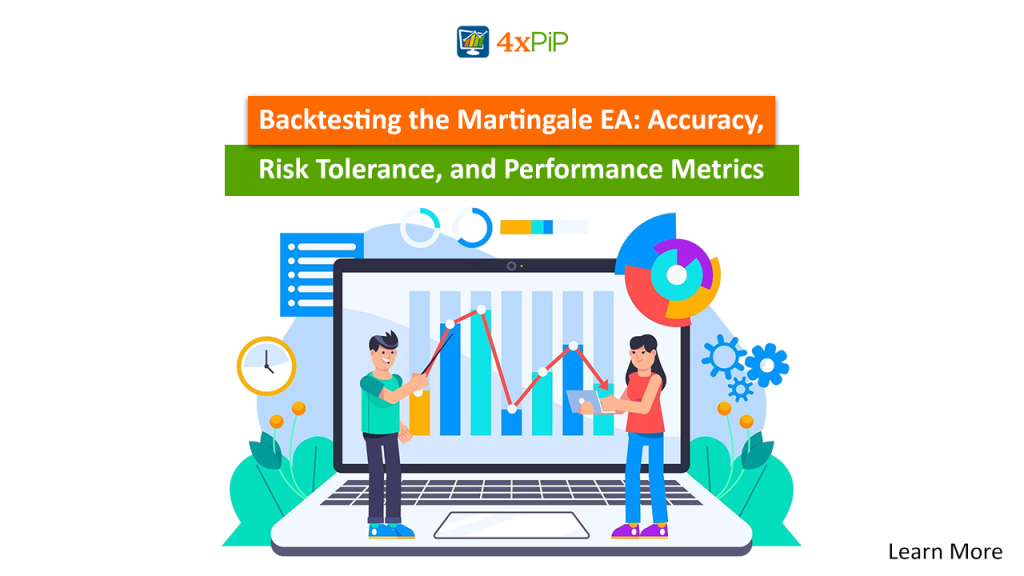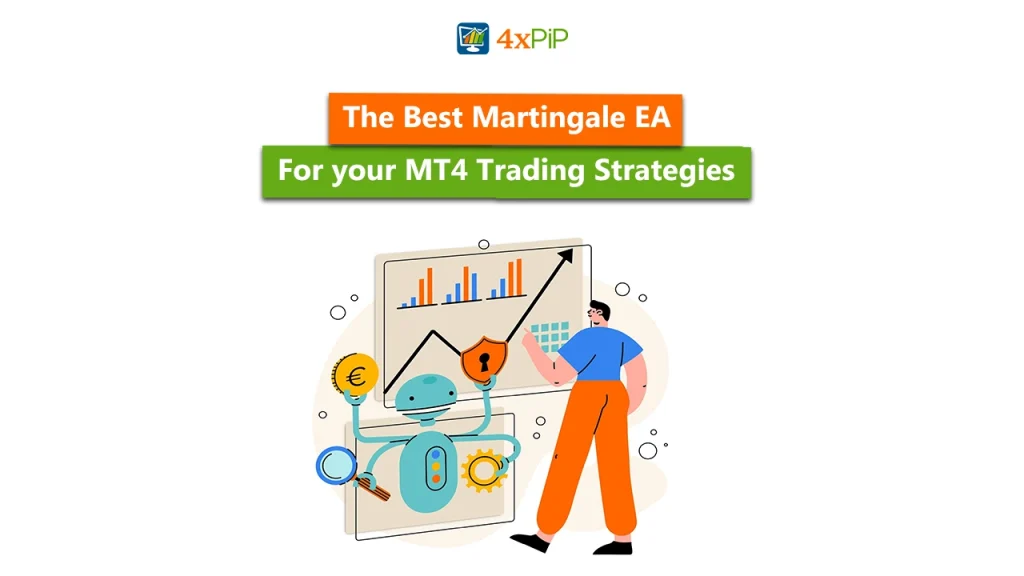Backtesting the Martingale EA is essential for measuring how well this grid-based recovery strategy performs under controlled market conditions. The process helps traders identify accuracy rates, analyze drawdown, and determine whether the system can sustain profitability during volatile or sideways movements. By using historical price data in MetaTrader, traders can observe how the EA reacts to rapid reversals, widening spreads, or long consolidations, factors that often expose weaknesses in untested algorithms. The goal is to understand how position sizing, trade intervals, and centralized take-profit levels influence performance across different market environments.
You can explore how this approach works in the 4xPip Martingale EA.The EA will automatically display the number of open trades, profits, and performance metrics on the chart, allowing traders to fine-tune settings for maximum profitability. By backtesting with 4xPip’s automated system, traders gain precise control over performance evaluation and can confidently optimize their Martingale strategy before live deployment.
The Mechanics of the Martingale EA
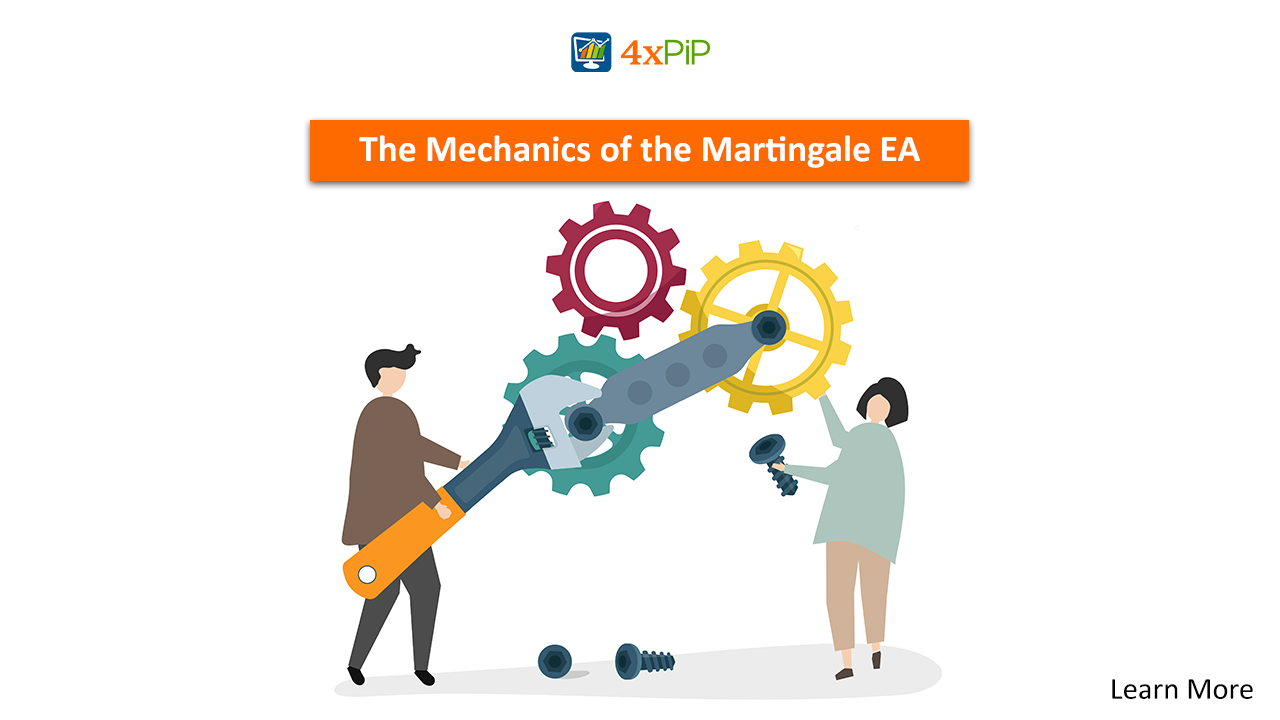
The Martingale strategy in algorithmic trading is built around recovery-based logic, increasing trade sizes after a loss to recover previous drawdowns when the market reverses. Each losing position triggers the next order at a larger lot size, allowing profits from a single winning trade to offset earlier losses. This scaling process helps maintain profit consistency but also demands calculated control over lot multipliers, grid distance, and maximum trade limits. The strategy’s effectiveness depends on balancing aggression and capital allocation; when backtested properly, it reveals whether the system can sustain extended losing streaks while maintaining acceptable drawdown.
Using 4xPip’s Martingale EA, traders can automate this logic inside MetaTrader without manual intervention. Once installed, open the EA settings and configure your initial lot, lot multiplier, and steps (grid spacing). The EA automatically adjusts its centralized take-profit level, ensuring all open positions close together in profit once the target is reached. For added precision, users can backtest and fine-tune these settings in MT4’s Strategy Tester, allowing data-based control over how the system manages losses and recovers capital in live conditions.
Designing a Reliable Backtesting Framework
A valid Martingale EA backtest begins with data accuracy. Traders must ensure they use 99.9% tick-quality historical data to replicate realistic market behavior. Proper spread settings and execution delays should also be configured, simulating how trades would have been executed under live broker conditions. The modeling accuracy in MetaTrader’s Strategy Tester determines how closely the EA reflects real execution, making it vital for evaluating metrics like drawdown, profit factor, and average recovery period. Start with a realistic initial deposit, moderate lot size, and a time frame that matches your trading frequency. For example, short-term grid strategies perform best on M15 or M30 charts, while long-term testing benefits from H1 or H4 data. Backtesting across multiple cycles and volatility periods, such as high-impact news weeks or calm market phases, helps confirm that the EA maintains consistent recovery behavior.
When setting up the 4xPip Martingale EA, traders can begin by loading it onto their desired currency pair. In the Strategy Tester, choose the “Every tick” model for highest accuracy and run several test cycles across pairs like EURUSD, GBPUSD, and USDJPY to assess adaptability. Adjust key parameters such as lot multiplier, steps, and centralized take-profit to align with your risk tolerance. The EA’s built-in display on the chart will show open trades, profit levels, and performance data in real time, helping traders evaluate the strategy’s resilience under different conditions. As developers, we at 4xPip ensure that each bot, whether used by an EA owner or customized for a user, operates with precise technical logic and risk control, allowing traders to refine performance through well-structured, data-backed testing.
Key Accuracy Indicators in Martingale Testing
Evaluating a Martingale EA’s reliability requires focusing on measurable performance data. When backtesting, these core metrics form the foundation for understanding how your EA behaves across volatility, spread variations, and execution speeds.
Essential Accuracy Metrics:
- Win Rate: Measures the percentage of profitable trades per cycle. A consistent rate suggests that the EA’s entry logic and recovery mechanism are working in sync.
- Average Profit per Cycle: Indicates overall profitability for each complete trade sequence, helping detect imbalance between recovery trades and profits.
- Recovery Frequency: Tracks how often the EA activates its counter-trade logic after losses. A balanced recovery frequency shows effective use of the Martingale phenomenon without excessive risk exposure.
- Equity Curve Stability: A smooth curve signals accurate modeling, minimal slippage, and stable grid spacing across test runs.
- Standard Deviation Reports: Quantifies fluctuations in profit and drawdown, helping identify irregular behavior or execution lag.
Testing with Visual and Statistical Tools:
Accuracy validation goes beyond numbers, visual tools like equity curves, trade logs, and tick-by-tick reports expose where execution deviates from expected performance. A sudden slope change in the equity curve, for instance, often points to data quality issues or unrealistic spread settings. Likewise, analyzing standard deviation across multiple test cycles helps confirm whether the EA maintains consistent trade spacing and recovery timing.
When applied in practice, the 4xPip Martingale Strategy EA automatically displays open trades, total profits, and EA direction directly on the MetaTrader chart. This makes accuracy verification easier without external scripts or manual reporting, allowing traders to focus purely on refining their strategy.
Measuring Risk Tolerance and Drawdown Levels
When testing a Martingale EA, one of the most important goals is to understand how much loss your account can handle before recovery begins. This is measured using two key indicators; maximum equity loss and relative drawdown percentage. Maximum equity loss shows the biggest drop your balance faced during testing, while relative drawdown expresses that drop as a percentage of your total equity. These numbers help traders see how risky a strategy truly is. For example, if your drawdown regularly crosses 30%, it may mean your lot sizes or number of recovery trades are too high. Comparing these results across different pairs and market conditions helps identify safe limits where your risk remains controlled and the EA still performs efficiently.
To put this into action, start by installing the 4xPip Martingale EA on MetaTrader. Open the input settings and define your stop-out percentage, this automatically stops the EA if losses reach a certain point. You can then set your lot multiplier, choose how many martingale orders the EA can open, and adjust the centralized take-profit to manage grouped trades. The EA works with built-in equity protection, lot management, and a recovery system that reduces drawdown through counter trades. We designed it so traders can fine-tune their strategy according to their own capital and comfort level. With these settings properly configured, the 4xPip Martingale EA provides a realistic way to measure and control trading risk.
Evaluating Performance Metrics Across Market Conditions
Performance evaluation is only meaningful when tested across different types of market behavior. In trending markets, a Martingale EA often faces challenges because prices move strongly in one direction before recovery trades can activate. In contrast, during ranging or sideways conditions, the strategy performs more smoothly since counter trades can close faster within smaller price fluctuations. To measure true adaptability, traders should analyze profit factor, expected payoff, and recovery ratio from their backtests. A profit factor above 1.5 indicates stable performance, while a higher recovery ratio shows how effectively the EA rebounds after drawdowns. Comparing these metrics between trending and ranging phases helps determine whether the EA’s profitability is worth its inherent risk exposure.
To test this efficiently on the Martingale EA, run it on MetaTrader and run backtests on pairs that behave differently, such as EURUSD (ranging) and GBPJPY (trending). The EA automatically adjusts its centralized take-profit and lot management settings as market direction shifts. Our system executes counter trades during drawdowns, recovers grouped losses through its recovery mechanism, and displays results directly on the chart. By observing how the profit factor and expected payoff vary between these market types, traders can see whether their chosen parameters remain consistent. This process gives a realistic view of how the Martingale EA performs across all conditions, helping traders align profitability targets with actual risk tolerance.
Translating Backtest Data Into Practical Application
Once backtesting results are complete, the next step is applying those insights to real-world conditions. Traders usually interpret performance metrics like drawdown, profit factor, and recovery rate to set realistic profit goals and acceptable risk levels for live accounts. But before any live deployment, forward testing on a demo account is very importantl. It verifies that the same settings that performed well during backtesting hold up under real-time price fluctuations and spread variations. Keeping detailed records of forward-test trades like lot size, entry time, trade direction, and exit outcomes helps confirm whether the strategy’s edge remains consistent. Over time, these logs form a clear picture of performance stability, letting traders make adjustments only when necessary rather than out of emotion or impulse.
To apply these results in practice, traders can start by installing the 4xPip Martingale EA on MetaTrader. After attaching it to a demo chart, open the settings to define your lot multiplier, martingale orders, and stop-out percentage based on the backtested drawdown range. The EA automatically manages trade size through its lot management system, places recovery trades using the martingale phenomenon, and adjusts a centralized take profit to close all grouped trades in profit. We designed it to recover drawdowns through counter trades and maintain visible trade metrics directly on the chart. By combining these built-in risk tools with periodic reviews of your trade logs, you ensure that backtest results translate accurately into live conditions, creating a disciplined, data-backed trading approach powered by the 4xPip Martingale EA.
Summary
Backtesting the Martingale EA provides traders with a realistic picture of how this grid-based recovery strategy performs under different market conditions. It highlights important factors such as accuracy, drawdown, and recovery potential, helping traders refine lot multipliers, grid distances, and centralized take-profit levels for sustainable performance. Those who build their own trading bot for MT4, MT5 or TradingView can use backtesting to evaluate risk tolerance, optimize position sizing, and enhance strategy resilience across both trending and ranging markets. With tools like the 4xPip Martingale EA, traders gain precise analytical control, enabling them to verify profitability through real data before deploying to live accounts.
4xPip Email Address: [email protected]
4xPip Telegram: https://t.me/pip_4x
4xPip Whatsapp: https://api.whatsapp.com/send/?phone=18382131588
FAQs
- What is the purpose of backtesting a Martingale EA?
Backtesting helps traders evaluate how well the EA performs under different market conditions, highlighting drawdowns, recovery rates, and long-term profitability before live trading. - How does the Martingale strategy work in trading bots?
It increases lot sizes after each losing trade, aiming to recover past losses when the market reverses, ensuring that one profitable trade offsets previous drawdowns. - Why is accurate data essential for backtesting results?
Using 99.9% tick-quality historical data replicates real broker conditions, improving the accuracy of drawdown, profit factor, and recovery evaluations. - What metrics should traders analyze when testing a Martingale EA?
Key metrics include win rate, profit factor, recovery frequency, equity curve stability, and standard deviation, each reflecting the EA’s accuracy and risk exposure. - How can traders measure risk tolerance in backtests?
By tracking maximum equity loss and relative drawdown, traders can identify safe parameters for lot sizing and recovery trades based on their account balance. - Why do Martingale strategies perform differently in trending vs. ranging markets?
Trending markets often delay recovery trades, while ranging conditions allow quicker profit closures. Testing across both helps ensure consistent results. - How does forward testing confirm backtest reliability?
Forward testing on a demo account validates whether the same settings that succeeded in backtests can sustain performance in live market conditions. - What role does risk management play in Martingale EA design?
It ensures capital protection by controlling lot multipliers, setting stop-out levels, and limiting the number of recovery trades within acceptable drawdown limits. - How does the 4xPip Martingale EA assist in backtesting and optimization?
It automates performance tracking by displaying open trades, profits, and metrics on the chart, helping traders fine-tune strategy parameters directly in MetaTrader. - What’s the best way to apply backtest results in live trading?
Start by testing your chosen settings on a demo account, record trade logs, and make adjustments only after consistent performance validation to ensure long-term stability.

